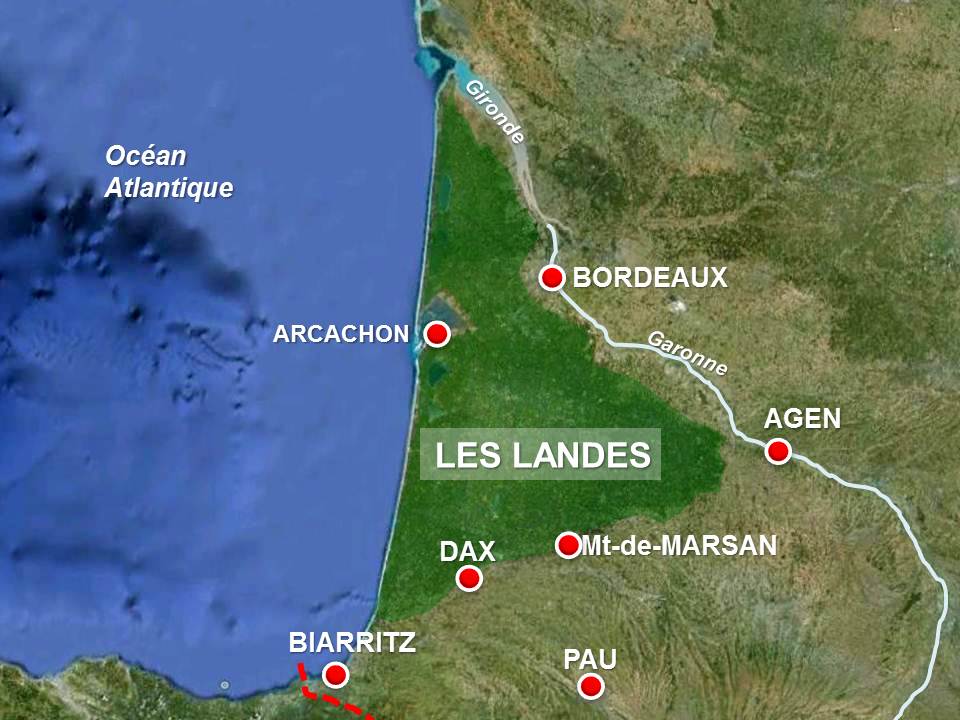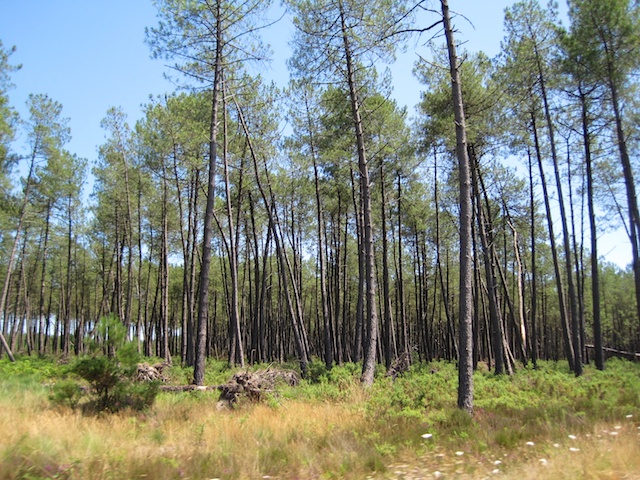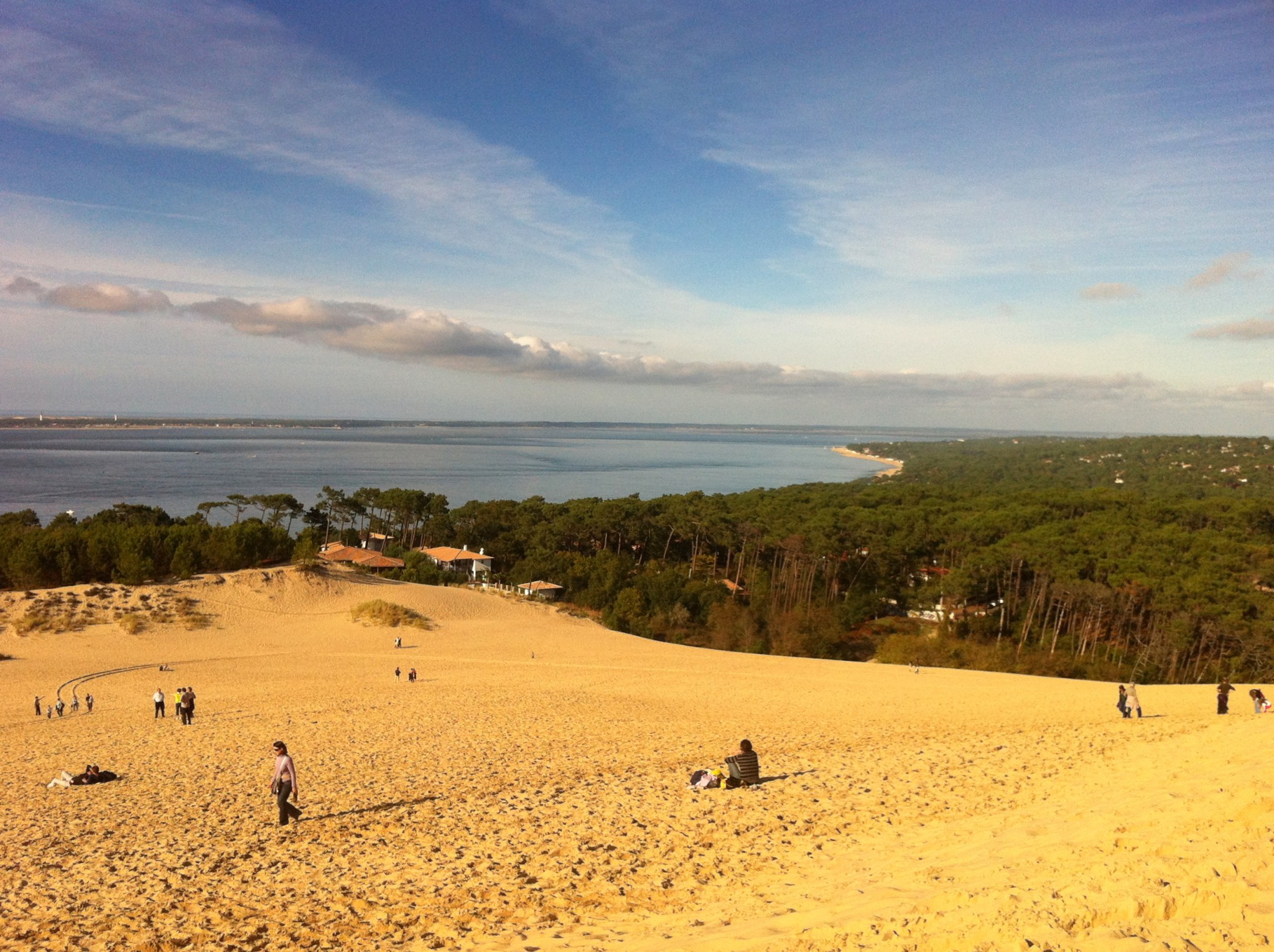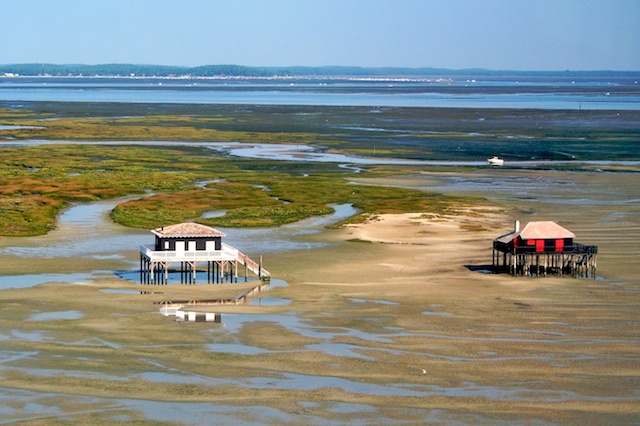The spicy scent of the pines, the sound of the grasshoppers. The pinch of the resin that dried on your skin after you picked up a pine cone or walked, carefully but barefoot, on the springy rugs of pine needles. The monotonous and relaxing landscapes, where plains of bracken and heather alternate with forests of tall pines. The hot air, urging you to bathe in the heavenly cold ocean. The salty air of the western wind and the strength of the waves push you back to the shore. The warmth of the sand under your feet on the endless beaches and their dunes, or its coolness under the shadow of the trees. Welcome to the Landes!
Situated in the Aquitaine region (South West of France), between the Garonne and the French Basque Country, the Landes of Gascony include the biggest forest of France, the longest French beach, and several of the most famous summer holiday destinations of France. Its simple geography is best described from West to East.

In the West, the Atlantic Ocean skirts the Landes. Its temperature rarely exceeds 21° Celsius, but during the hot summers of the South West of France, it is usually a relief. It is strongly advised to bathe in the swimming areas that are marked and patrolled by lifesavers. Lifesavers also hoist flags to inform the bathers: green for safety, orange for caution and red when it’s not safe to swim.
Even the locals respect these areas and flags, mostly because of the danger that the “baïnes” represent. They are temporary depressions dug in the sand, natural pools formed along the beach which open up at their extremities. The currents that empty these “baïnes” can violently drag the swimmers far from the shore. Resisting is useless; the only solution is to save your energy and to help the lifesavers notice you.
But you can safely bathe in the swimming areas, and confident swimmers will enjoy the strength of the waves of the Atlantic Ocean. Buy a body-board (we also call them “Morey” in the South West) and let the waves push you to the shore!
These waves are highly appreciated by the surfers, who come from all around the world to enjoy the surf spots of Lacanau and Hossegore. Famous surfers gather every year to participate in the Soöruz Lacanau Pro, an international top-level surf competition.
The Landes are also a paradise for beach lovers: between the sea and the Landes’ forest, an almost endless (more than 200 km) beach of yellow sand stretches from Soulac (North) to Hossegore (South). The most famous parts of this Silver Coast (Côte d’Argent) are Lacanau, Le Porge, Lège-Cap-Ferret, Mimizan, Biscarosse and Hossegore. This beach is not only long, but it is also very wide. This allows tourists and locals to enjoy numerous outdoor activities.
The main activity there is sunbathing. You will easily find a nice space to spread out your towels. But don’t forget your sunbathing equipment: sunscreen, beach umbrella, flip flops (or as the Aussie’s say “thongs”!) because the sun and the sand are very hot, and possibly something to shelter from the sand in the air on the windy days.
The strong wind that sometimes blows on the Landes is perfect for kites or for land-yachting and sailing. The favourite waters of the sailors are usually the Arcachon Bay (Bassin d’Arcachon) and the lakes of Lacanau and Hourtin-Carcans.

If you like to have hotels, night clubs, restaurants and bars next to your beach, Lacanau is a good option. But if you prefer camping and beaches that are less crowded with tourists, you will appreciate beaches such as Le Porge, which is a favourite with the locals. If you do not want to share the beach with anybody, just take a long walk along the beach, in either direction, North or South and you will soon find a less crowded spot. Just be aware that you will probably meet a few naturists on your way!
The frontier between the beach and the forest is a long ensemble of dunes. The wind used to push big quantities of sand on the land, damaging the forest and forcing the inhabitants to move their villages. The dunes were eventually stabilised with oyats, a good fixing plant, in the 19th century. Today the ONF (National Office of the Forests) supervises the protection and the maintenance of the dunes.
The access to the dunes is forbidden around the main beaches, but if you go a bit further, it is possible to walk on the dunes or to find a nice place to relax, away from the other tourists and sheltered from the wind.
The Dune du Pyla

The most famous dune of France, and the highest of Europe, is the dune du Pyla (dune of Pyla, or Pilat). It is situated at the entrance of the Arcachon Bay. It is 500m wide from East to West, and 2,7km long from North to South. Its altitude varies from 100 to 117m. It contains about 60 million cubic metres of sand. Its slope is steeper on its land side than on its sea side. Its creation started with the streams that carried sand along. This sand made the Arguin shoal, whose sand is carried by the wind to the land, where it becomes a part of the dune du Pyla. Like the other dunes of the Landes, the dune du Pyla is blown toward the land by the wind, covering the forest, the buildings and the roads with sand.
The dune of Pyla was rehabilitated by the Ministry of Territory Development and Environment in order to preserve it while welcoming, informing and guiding the numerous tourists who visit it. Visitors usually go up the dune via stairs, but the sportiest like to climb up the steep sand slope, which is unfortunately not so good for the preservation of the dune.
The top of the dune can be very windy, but if you go down in the direction of the sea you might find a nice picnic spot. Behind you, the deep green forest spreads beyond the horizon. In front of you, you can admire the entrance of the bay and the Arguin shoal. This high dune is also a coveted location for hobbies such as paragliding and radio-controlled gliding.
As you go down the dune to go back to your car, you might be tempted to slide in the sand. It is not forbidden, but keep in mind that accidents are quite frequent and sometimes serious, and that it speeds up the movement of the dune toward the forest.
The Bay of Arcachon

Arcachon Bay is the only break in the almost endless beach of the Landes. It is one of the most visited sites of the South West of France. Unlike the great lakes of the Landes, this triangle shaped bay is opens wide onto the Atlantic Ocean. Twice a day the tide makes huge quantities of water flow in and out, via a 3km wide array of trenches dug in the sand by streams. During high tide, the small inland sea has a surface of 155km². When the tide is low, this surface is only 44km²: it is possible to walk in the sand and in the silt to collect shellfish, or to access the Birds Island, which is a famous spot for migratory birds. You will probably want to take a picture of the traditional wooden houses that the fishermen built on stilts, adapted to the very high tides. You can also savour the delicious oysters that are raised in the bay, and enjoy yachting on a long and narrow “pinasse”, or sailing and fishing. However, be careful, the streams and the shape-shifting channels can make navigation difficult.
The long chain of dunes that extends the Pyla dune and the Arguin shoal to create the bay is the Cap Ferret with its light-house towers over the entrance of the bay. It is a posh holiday destination combined with a well preserved natural environment. You might meet a few French celebrities there who love to escape to this haven where they can find a bit of privacy: Pascal Obispo, Jean-Paul Belmondo, Patrick Poivre-d’Arvor, Yannick Noah, Jack Lang…
The forest of the Landes
Isolating the beach from the rest of France, the 14 000 km² forest is the main element of the Landes de Gascony. It used to cover only 2 000 km² of the area, but a systematic afforestation of the dunes and of the plains since the 18th century transformed the landscape: it is a cultivated forest. Consequently, only 10% of its surface is owned by the French state or by local governments. The rest is exploited by foresters. 80% of the trees are maritime pines, and the remaining 20% are mostly oaks. At the North of the forest, next to the famous Médoc châteaux you can visit a few vineyards where maritime pines coexist with the grape-vine. On the green hills of the South, the pines are less numerous and, on good days, it is possible to see the shape of the Pyrenees (a mountain range that France shares with Spain). Next to the sea, on the Côte d’Argent, the tall maritime pines shelter shorter but vigorous green oaks and cork oaks. In the centre of the forest, a few rivers feed “gallery forests” that protect them and the kayakers from the hot sun.
Practical Info
We recommend you visit the Landes of Gascony in June, July and August, during the French summer. The weather is sunny most of the year, but the winter is generally rainy and the area loses a lot of its charm during the cold season (11/12°C in winter), except if you enjoy walks on deserted beaches and land-yachting. Moreover, the autumn and winter tempests can turn your holiday into a nightmare (more than 170 km per hour in 199 and 2009).
The summers are usually hot and dry (25/26°C), but rarely scorching. Regarding bathing and surfing, the average temperature of the Atlantic Ocean during summer is 20°C, but the hot sun and the strong waves will not let you get cold. In the Arcachon Bay, the temperature of the water can reach 22° or 23°C. If you can’t stand cold water, we advise you to swim and sail in the soft water of the Lake of Hourtin-Carcans, around the beaches of Maubuisson and Bombannes: the view on the forest that surrounds the biggest natural lake of France is breathtaking, and the water is surprisingly warm.
How to get to the Landes
The Landes are easily accessible by car from Bordeaux, as well as from Biarritz thanks to an excellent network of motorways. The A660 motorway links Bordeaux to Arcachon, while the A63 crosses the forest of the Landes North-South between Bordeaux and Bayonne. Parallel to the East, the newly opened A65 links Bordeaux to Pau.
From Paris Gare Montparnasse, there are approximately 20 daily TGV trains to Bordeaux, taking between 3 and 4 hours.
If you are travelling from Australia or America, the best way to reach Bordeaux and the Landes is to take a flight to Paris Charles de Gaulle airport and take either a TGV train, or a domestic flight from there.
Visit the Tourist Board of the Landes for more info.
Featured image: Landes de Gascogne © Antoine Gratian



